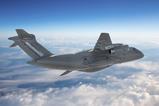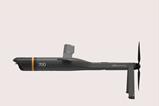Manama’s strengthened military capability is proudly on display at the Bahrain air show, with its air force’s newest and most capable-ever combat aircraft to take a starring role.
The first three Lockheed Martin F-16s to be delivered to Manama in the airframer’s Block 70 production standard touched down at Isa air base in March 2024. Their arrival followed the transfer of a lead pair of fighters to Edwards AFB in California last year, to support testing and training activities.
A trio of Block 70 jets are due to appear during the show’s opening ceremony, as part of a flypast also to include six of the Royal Bahraini Air Force’s (RBAF’s) legacy Block 40-standard jets.
Eleven of Bahrain’s 16 on-order aircraft have been delivered so far, with nine of these now operational in the country. Notably, early August saw the arrival of a single-seat fighter with the registration 18-0006, which has the distinction of being the 4,600th F-16 built during the programme’s more than half-century history.
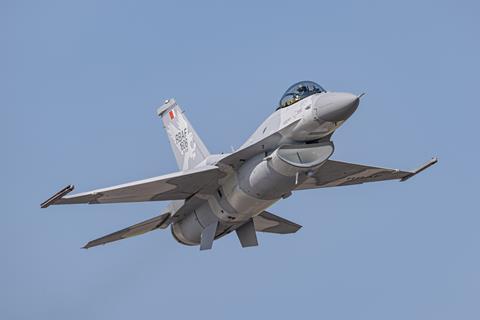
The RBAF’s remaining five aircraft are currently in various stages of production and assembly at Lockheed’s Greenville site in South Carolina, the airframer says.
“Bahrain’s F-16 Block 70 programme highlights the strength of partnership and heritage between the US government, Bahrain and Lockheed Martin, rooted in shared values spanning defence, economic, and cultural and social ties,” the company says.
“Bahrain has a distinct history with the F-16 as the first operator in the Gulf Cooperation Council [GCC], further distinguished by receiving the first F-16 Block 70,” it adds.
Meanwhile, the RBAF’s lead two aircraft remain based at Edwards AFB, where they are being flown with the US Air Force (USAF).
“The 416th Flight Test Squadron’s rigorous evaluation of the F-16 Block 70 jets ensures that these aircraft meet the highest standards of performance and safety, which is crucial for the operational success of Bahrain’s air defence forces,” the USAF unit says.
“The Airpower Foundations CTF [combined test force] delivers relevant capabilities to our allied warfighters against the current threat environment through F-16 Foreign Military Sales test and evaluation, strengthening strategic partnerships and front-line deterrence,” it says.
NEW CAPABILITIES
Capabilities introduced with the Block 70/72 standard include Northrop Grumman’s APG-83 active electronically scanned array radar, plus “advanced avionics, a modernised cockpit with new safety features, advanced weapons, conformal fuel tanks [CFTs], and an improved-performance engine”, Lockheed says.
The airframe’s structural life also has been extended to 12,000 flight hours: more than twice that of earlier F-16s, and equivalent to at least 40 years of operational use. Maximum take-off weight climbs to almost 21,800kg (48,000lb), with engine thrust in the 29,000lb (129kN) class.
Lockheed notes that the CFTs – which increase internal fuel capacity by almost 1,360kg – provide extended range “without sacrificing the aerodynamic performance of the jet”.
“This advanced aircraft significantly boosts Bahrain’s deterrence capabilities and reaffirms the nation’s commitment to safeguarding its sovereignty and ensuring regional stability,” the company says. The RBAF’s newest assets can deploy Raytheon AIM-120 AMRAAM and AIM-9X Sidewinder II air-to-air missiles and JDAM-series precision-strike weapons.
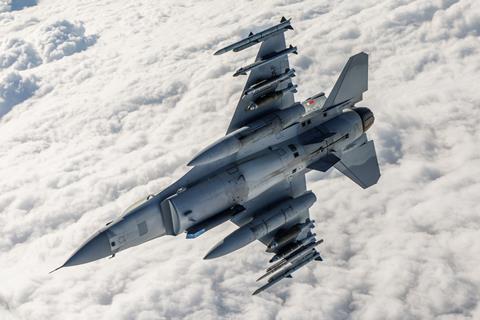
Lockheed – which in January 2024 marked the 50th anniversary of the YF-16 prototype’s first flight – has a production backlog including jets for Bulgaria, Jordan, Morocco, Slovakia and Taiwan. Turkey also is advancing towards confirming a planned 40-aircraft follow-on buy.
Speaking earlier this year, OJ Sanchez, vice-president of Lockheed’s integrated fighter group, said the airframer expects to secure orders for another 300 F-16s over the life of the programme.
“There are a lot of countries with interest,” he says, while describing the model as “an affordable, powerful and effective solution”.
Meanwhile, Bahrain’s other most significant recent procurement – of a dozen Bell AH-1Z attack helicopters – has been completed, with the RBAF receiving its final examples early last year. The service gave a home show debut to the type at the 2022 event, where one of the aircraft appeared in the static display.
“As a leader in the region, Bahrain’s defensive capabilities will be further bolstered by the advanced technologies of the Viper,” Bell vice-president and H-1 programme director Mike Deslatte said at the time of the final deliveries.
With a maximum gross weight of 8,390kg, the AH-1Z has a useful load of around 2,600kg, enabling it to carry weapons including Lockheed AGM-114 Hellfire air-to-surface missiles and BAE Systems APKWS II precision-guided rockets.
“Bell will support the lifecycle of the aircraft to ensure reliability, survivability and lethality on the modern battlefield,” the company notes.
Thanks to its recent investments in the F-16 and AH-1Z, Bahrain’s armed forces now operate a total of 132 military aircraft, FlightGlobal’s soon-to-be-published 2025 World Air Forces directory shows. That marks an increase from 115 ahead of the 2022 show.
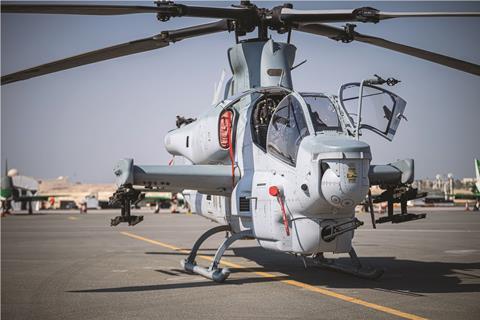
Including its legacy examples, the service has 28 F-16C/Ds in active use, including two-seat trainers. Its transport assets total two Lockheed C-130Js – acquired secondhand from the UK and fielded from 2018 – and a single Cessna 208 Caravan.
The RBAF’s dozen AH-1Zs are supported by 22 older E/F-model Cobras, while its transport helicopter fleet comprises 21 Bell 212/412s and eight Sikorsky UH-60M Black Hawks.
A diverse training aircraft fleet totals 12 Northrop F-5s, six BAE Hawk 129s and three Slingsby T67M260s, plus eight AH-1P, three Bell 505 and four MBB BO105 helicopters.
Notably, Bahrain is the only member of the six-nation GCC grouping to operate the F-5, with the only other Middle East-region users being Iran and Yemen.
The remainder of Manama’s military fleet counts two BO105s operated by the Royal Bahraini Navy.
Excluded from our analysis are a trio of BAE Avro RJ85/100 quadjets, which are employed by the air force in the VIP transport role.
The RBAF does not have any other current procurement programmes, but the oldest of its current assets include its F-5s, Bell 212/412 and BO105s, pointing towards potential future equipment needs.
In terms of its regional standing, Bahrain’s assets rank it fourth in fleet size among the GCC partners, who also include Kuwait, Oman, Qatar, Saudi Arabia and the United Arab Emirates. But its recent additions have seen it edge ahead of Kuwait and Oman, which both have 128 military aircraft in service.
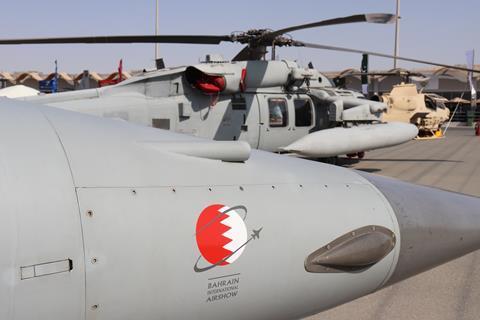
Once combined, the GCC’s air power total is 2,106 aircraft. This includes 693 combat aircraft, 47 special mission, 28 tankers, 112 transports, 728 combat helicopters and 498 training aircraft/helicopters.
Bahrain accounts for just 6% of that combined strength, which is dominated by Saudi Arabia (44%), the UAE (26%) and Qatar (12%).
REGIONAL POWER
Together, the GCC nations have 46% of the combined total of 4,595 military aircraft recorded as operational in the wider Middle East region. That sum also includes the inventories of Iran, Iraq, Israel, Jordan, Lebanon, Syria and Yemen.
GCC partner participation at the show includes Royal Saudi Air Force Boeing F-15SA and Eurofighter Typhoon combat aircraft, along with the service’s Saudi Hawks aerobatic display team. Notably, the distinctive green and white-liveried Hawk 65s it currently employs are to be replaced with the newer 165 model, it was announced at the World Defense Show near Riyadh earlier this year.
The UAE, meanwhile, has sent F-16 and Dassault Aviation Mirage 2000-9 fighters to this year’s event.
In addition to its relationship with GCC partners, Bahrain maintains strong links with the US military.
Building on their decades-long relationship, Manama and Washington, DC in late 2023 signed a Comprehensive Security Integration Agreement, which seeks to “enhance cooperation on issues ranging from defence and security to emerging technologies and trade”.
Noting that Bahrain hosts the US Navy’s Fifth Fleet, Washington says the nation “remains as one of the United States’ longest-standing partners in the Middle East”.
“The United States remains committed to Bahrain and the region,” secretary of defence Lloyd Austin said at the time. “We will continue to work with you to push back against all threats to regional stability both from states and non-state actors.”
As evidence of their partnership, the USAF’s 378th Air Expeditionary Wing staged exercise Ballast Cannon 24.8 with the RBAF from 9 July.
“As a routine exercise occurring nearly quarterly, this iteration supports rapid expeditionary capabilities by integrating air-to-air training objectives between the Royal Bahraini Air Force and US Air Force aircraft and operational support personnel,” the unit says.
USAF assets involved in the manoeuvres were F-16s deployed from Aviano air base in Italy, and a Boeing KC-135 tanker, with activities including “aerial refuelling, coalition command and control, and tactical integration”.
“The bilateral training focuses on strengthening the bonds between coalition forces and building a foundation for future engagements in support of the combined defence of the Arabian peninsula,” the USAF says. It adds that such activities “enhance strategic basing capabilities and strengthen coalition interoperability”.























